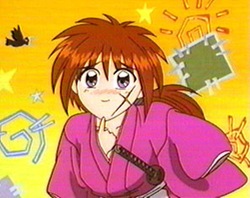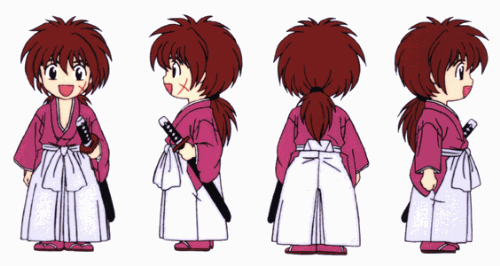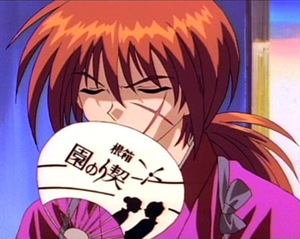Rurouni Kenshin. Review
Perhaps the astonishing thing about Rurouni Kenshin’s consistently strong following over the years is that the series is staggeringly inconsistent. For the first thirty episodes, it’s quite possible that I watched the same cliché on repeat. Some glory-hunting thugs or evil yakuza challenge a buffoonish Kenshin to a fight, only to end up beaten to a pulp at his feet. What’s more, roughly thirty episodes from the end, Rurouni Kenshin plunges into a cesspit of filler arcs from which it never recovers. The result is that, out of ninety-five episodes, less than half that number actually consists of must-watch storytelling. Put in another way, out of thirty-eight hours of your life that this anime will claim, twenty-six of those will constitute a tragic waste. Following this, do the middle episodes of dark samurai tragedy make Rurouni Kenshin worth following as a whole?
The short answer is no. Spend thirty-eight hours doing something else.
The long answer is no… well, yes… okay, quite possibly. However, individual enjoyment will clearly depend on how keen you are to experience exceptional shounen action, and, more importantly, how forgiving you are when you don’t.
To describe Rurouni Kenshin at its best, namely during the Kyoto arc, is to say that it stands head and shoulders above the vast majority of other shounen anime – yes, damnit, it’s better even than Tengen Toppa Gurren-Lagann. In my view, the Kyoto arc is so powerful because the conflicts are rooted in the tragedies of the Meiji revolution. In this period, democracy and gunpowder are pushing an unknown modern frontier. Often, Kenshin faces embittered traditionalists (now turned vagabonds and terrorists) who are desperate to slow the wheels of change.
Tailing thirty episodes of lacklustre mini-stories, the Kyoto arc introduces a revved up Kenshin full of torturous inner conflict and a political backdrop steeped richly in Japanese history. While I accept that the educational value of the series is very low (there are men in trench coats, for God’s sake, shouting cheesy martial arts moves that produce lightning), the bittersweet setting, so full of painful dilemmas, still feels like the next best thing to actual history. For Western audiences, in particular, this romanticised combination of old Japan (dojos, tatamis, and katanas) with modern age trimmings (guns, edgy costumes, and informal dialogue) will be highly appealing.
Significantly, even the fights are more enjoyable during the Kyoto arc than all the other periods. Mostly, the battles follow the same wearisome recipe: the opponents bluster for one minute, fight for two, and then spend ten more recounting their lives in an explanatory flashback. While the fights are technically unimpressive (bar one or two notables) and their outcome always predictable, the drama surrounding them in the Kyoto arc is intense and, thus, raises their entertainment value.
Everything else, unfortunately, is either redundant claptrap or just a less convincing copy of the Kyoto arc.
In terms of style, Rurouni Kenshin is closer to the likes of Ninja Scroll than, say, Stranger – Mukou Hadan. By this, I mean that motion is not exactly intricate, but the flashy use of still shots, pans, cuts, bold camera angles, and lightning special effects more than make up for the lack of detail. With that said, the quality of the animation, just like that of the plot, varies from scene to scene, and arguably from arc to arc. For example, when comparing the Kairyu pirate attack in episode twenty-five to the outstanding battle between Kenshin and Saito at the beginning of the Kyoto arc, the two action scenes look as if they come from different anime. While the first is plagued by awkward movement, flat colours, and inconsistent character proportions, the second is a nonstop thrill ride involving fluid movement, inventive stunts, and careful use of light.
Rurouni Kenshin’s population, as expected from any epic, is massive. Luckily, most of them are enjoyable, from the ludicrously clad Chou, whose hair looks like a broom, to the beautiful Doctor Megumi, who gets a lot of pleasure from teasing Kaoru. Most of the characters are likely to make a lasting impression, even if remembering their specific names might be difficult in the long term.
More importantly, the significant antagonists are of the kind that most will love to hate (or maybe even love to love). For example, Shishio might be relentlessly cruel and also look like a mummified version of Shredder from Teenage Mutant Ninja Turtles. Nevertheless, there is much pathos about Shishio’s twisted personality – no less because of his gruesome past – which makes watching his terrible actions a guilty pleasure.
If there is one criticism of the characters worth noting, it’s that too few of them show any kind of forward development. How they behave is almost exclusively defined by their past and always by way of lengthy flashbacks right in the middle of a fight. Some will turn from their bad habits (usually because of Kenshin’s heroic influence), and some will simply get physically stronger. Generally, though, they are what you see. Whilst this makes the characters highly memorable and highly sympathetic, each one tends to be a predictable and cheesy addition to the cast.
The music during the episodes consistently provides memorable accompaniments to perfectly capture every character and atmosphere. Besides this, it also achieves one of the most brilliant uses of an established classical piece, namely the intermezzo from Mascagni’s ‘Cavalleria Rusticana’ during a touching farewell scene.
However, while the creators of Rurouni Kenshin certainly know their mood music, they suffer a curious lapse in judgement when it comes to the main themes. Considering that the opening credits consist of macho montages and atmospheric close-ups, the choice of Dokuro-chan as lead vocalist warbling about two hearts fusing together seems unfortunate. I guess t
he second ending theme w
ith its up-beat electronic pop isn’t too awful, but, generally, the main themes suck.
As for the voice acting, I only wish to stress one point: watch the American dub at your own peril
Rurouni Kenshin is indeed awe-inspiring in several places, displaying the kind of jaw-dropping climaxes that would turn any anime into an instant favourite classic. Alas, these ‘wet my pants’ moments also come sandwiched between long intervals of epic mediocrity; too often during the first and final arcs the content is repetitive and tedious. As such, Rurouni Kenshin is memorable more for its defining moments than its plot as a whole. I will certainly not revisit the series in its entirety since so much of it is worthless, however, the Kyoto arc and a few choice mini-stories will no doubt continue to entertain me for years to come.
Rurouni Kenshin comes highly recommended for those who specifically love shows about invincible tragic samurai, or else those with herculean stores of patience.
“eXcetera Cafe” Fan-Fiction Rurouni Kenshin
Rurouni Kenshin








__THISRES__186768.jpg)




